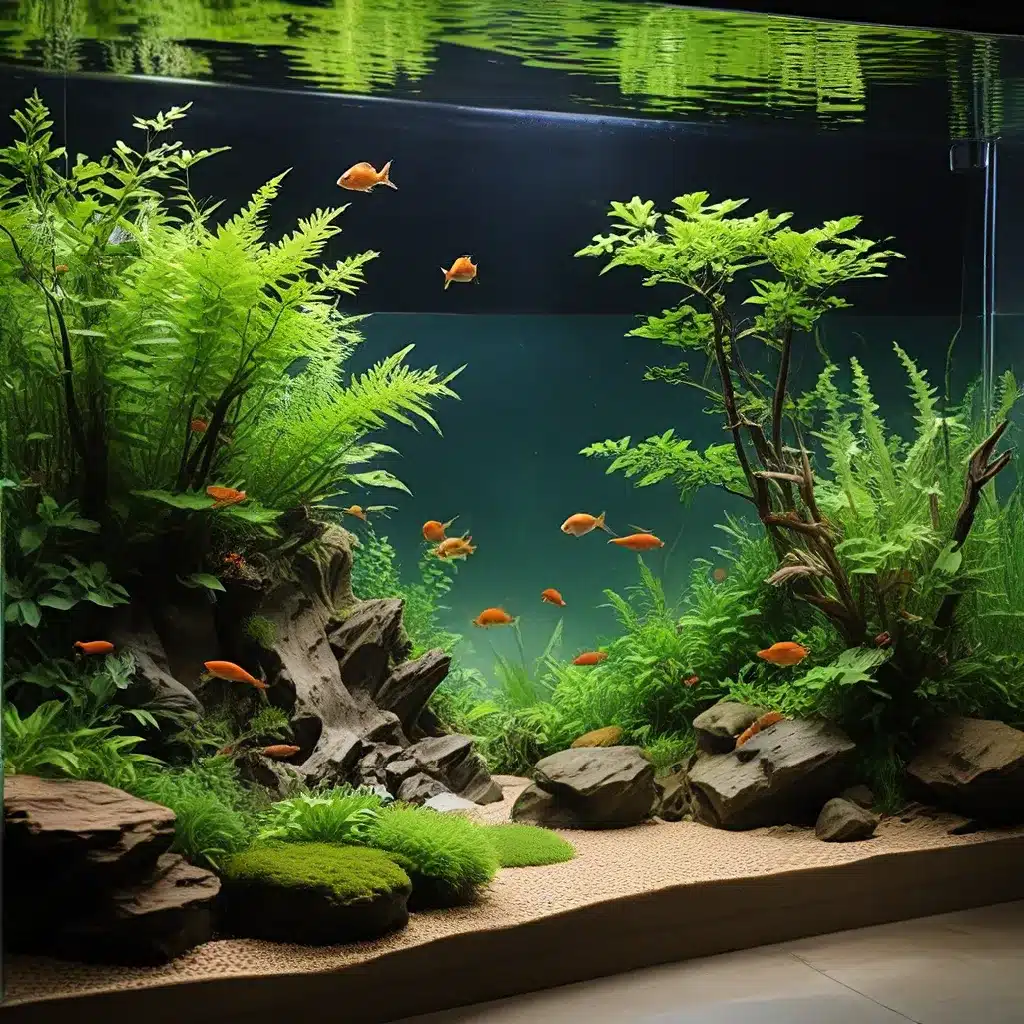
The Art of Aquatic Environments
Aquascaping, the intricate art of designing visually captivating aquarium landscapes, is a captivating pursuit that allows aquarium enthusiasts to transform their underwater habitats into breathtaking, naturalistic displays. One particularly compelling style of aquascaping is the biotope-inspired approach, where aquarists seek to recreate the specific ecological conditions and aesthetics of natural aquatic ecosystems.
By carefully selecting complementary plants, carefully positioning hardscape elements like driftwood and rocks, and thoughtfully incorporating freshwater fish species native to the target biotope, aquascapers can craft aquariums that truly evoke the essence of natural aquatic environments. This biotope-inspired aquascaping not only creates visually striking displays but also provides ideal living conditions for the aquatic inhabitants.
Aquascaping has evolved significantly over the years, with enthusiasts constantly pushing the boundaries of creativity and technical mastery. One particularly influential style that has emerged in recent decades is the nature aquarium, which emphasizes the use of lush, dense plantings and thoughtfully arranged hardscape elements to mimic the appearance and feel of natural underwater habitats.
Mastering the Art of Biotope-Inspired Aquascaping
Designing a biotope-inspired aquascape requires a deep understanding of the target ecosystem, as well as a keen eye for aesthetic composition and an appreciation for the intricate balance of natural systems. Aquascapers must meticulously research the specific plant species, water parameters, and fish communities found in their desired biotope, and then translate this knowledge into a cohesive, visually striking design.
One of the hallmarks of a successful biotope-inspired aquascape is the attention to detail and authenticity. Aquascapers must carefully select plants, rocks, and driftwood that accurately reflect the materials and textures found in the natural environment they are seeking to recreate. Proper placement and composition of these elements are crucial, as they not only contribute to the overall aesthetic but also create the necessary habitat conditions for the aquarium’s inhabitants.
Pawel Mielniczek’s Project Ryuboku, a stunning aquascape featured on ScapeFu, serves as an excellent example of the biotope-inspired approach. Mielniczek’s aquascape expertly captures the essence of a natural, riverbed-like habitat, with a masterful use of driftwood, rock formations, and carefully selected plant species to create a sense of depth, texture, and visual interest.
Designing for Depth and Perspective
One of the key challenges in biotope-inspired aquascaping is creating the illusion of depth and perspective within the confines of a relatively small aquarium. Aquascapers must employ various techniques to guide the viewer’s gaze and create a sense of scale and dimensionality.
The rule of thirds is a fundamental compositional tool that can be applied to aquascaping, ensuring that the key elements of the design are strategically placed to create a visually engaging layout. By positioning the primary focal points and hardscape features along the intersecting lines of the rule of thirds grid, aquascapers can establish a sense of balance and visual hierarchy within the aquarium.
Proper use of the golden ratio and the golden spiral can also help aquascapers achieve a harmonious, naturalistic composition. These mathematical principles, found throughout nature, can guide the placement of plants, rocks, and driftwood to create a sense of depth and visual rhythm.
Furthermore, the implementation of aerial perspective through the use of color and contrast can significantly enhance the perception of depth in an aquascape. By gradually reducing the saturation, contrast, and hue of the background elements, aquascapers can create the illusion of distance and a more immersive, three-dimensional environment.
Balancing Aesthetics and Functionality
Designing a biotope-inspired aquascape is not merely about creating a visually stunning display; it also requires a deep understanding of aquarium ecosystem dynamics and the specific needs of the inhabitant species. Aquascapers must carefully consider the water parameters, lighting requirements, and overall habitat suitability to ensure the long-term health and well-being of the aquarium’s residents.
One of the hallmarks of a successful biotope-inspired aquascape is the integration of aesthetic appeal and functional considerations. Aquascapers must strike a delicate balance between creating a visually captivating design and providing an optimal environment for the aquatic life within the aquarium.
The careful selection and placement of plant species plays a crucial role in this endeavor. Not only do the plants contribute to the overall aesthetic of the aquascape, but they also serve essential biological functions, such as oxygenating the water, absorbing waste products, and offering refuge and spawning grounds for the fish.
Likewise, the hardscape elements, including driftwood and rock formations, must be strategically positioned to not only enhance the visual appeal of the aquarium but also create the necessary habitat structures and water flow patterns that support the needs of the aquatic inhabitants.
Embracing the Beauty of Natural Aquatic Environments
The pursuit of biotope-inspired aquascaping goes beyond simply creating a visually stunning display; it is an ode to the beauty and complexity of natural aquatic ecosystems. By immersing themselves in the intricate details of these environments and translating them into carefully crafted aquarium designs, aquascapers can foster a deeper appreciation for the delicate balance and interconnectedness of the natural world.
Through the creation of biotope-inspired aquascapes, aquarium enthusiasts can not only enjoy the visual splendor of their underwater habitats but also cultivate a greater understanding and respect for the fragile ecosystems that exist beyond the confines of the aquarium. By emulating the natural beauty and functionality of these environments, aquascapers can inspire others to cherish and protect the diverse aquatic life that surrounds us.
Whether you are a seasoned aquascaper or a beginner exploring the world of aquarium design, the biotope-inspired approach offers a unique and rewarding opportunity to unlock the artistic and ecological potential of your underwater oasis. By embracing the principles of natural aquarium design, you can transform your aquarium into a captivating masterpiece that celebrates the remarkable beauty and complexity of the aquatic realm.

